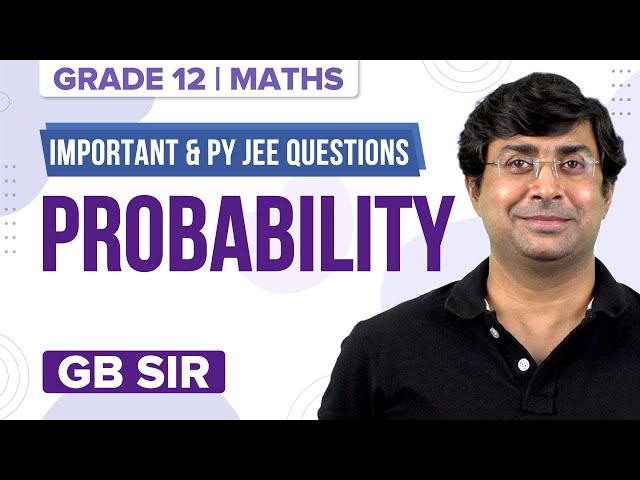Probability notes will definitely help students to understand the probability concept and fundamentals and also aid them with the formulas for every possible subcase and exceptions to rules. These probability notes will surely help in the last month when they will have a huge portion to revise, and they cannot find the right source. In short, the probability notes will make students’ exam preparation simpler, more organised and useful for recalling all the concepts that they have already learnt.
Important JEE Revision Notes on Probability – Definitions
What Is Probability?
The probability of an event tells us how likely the event will happen. The probability of an event is the measure of the chance that the event will occur as a result of an experiment.
The probability of an event is the ratio of the number of observations of the event to the total number of observations.
Probability with Replacement and without Replacement
Probability with replacement and probability without replacement are two important concepts we deal with when we work on probability problems.
Whenever we say probability with replacement, this implies that the events that are taken in the probability are completely independent of each other.
On the other hand, when we find probability without replacement, this implies the events in the probability to be determined are dependent on each other.
Independent Events
Two events are said to be independent only when the occurrence of one does not at all affect the occurrence of another. In such cases, the probability of the events also does not get affected at all by each other.
Dependent Events
When two events are dependent on each other, it means that the occurrence of the first event affects the occurrence of the next event, which further affects the probability of the events.
Complementary Events
The possibility that there will be only two outcomes which state that an event will occur or not.
Equally Likely Events
The results of a sample space are called equally likely if all the events have the same probability of occurring.
Bayes’ Theorem
Bayes’ theorem describes the probability of occurrence of an event related to any condition.
Formula:
If A and B are two events, then the formula for Bayes theorem is given by:
P(A|B) = P(A∩B)/P(B)
Where P(A|B) is the probability of the condition when event A is occurring while event B has already occurred.
P(A ∩ B) is the probability of event A and event B.
P(B) is the probability of event B.
IIT JEE Probability Notes – Formulas
1. The formula to find the combined probability of events obtained with replacement, and we simply find the product of the probabilities of the event directly:
P (A ∩ B) = P (A) P (B)
2. The conditional probability of an event with respect to another event is the probability of occurrence of the event after the first event has already taken place.
P (A∩B) = P (A) P (B|A)
3. Rules of Addition
For two events A and B, if their probabilities are written as P(A) and P(B), then the rules of addition can be written as,
Rule 1 (Mutually Exclusive Events):
P(A or B) = P(A) + P(B)
P(A + B) = 1
Rule 2 (Non-mutually Exclusive Events):
P(A or B) = P(A) + P(B) − P(A and B)
4. Rules of Multiplication
For two events A and B, if their probabilities are written as P(A) and P(B), then the rules of addition can be written as,
Rule 1 (Mutually Exclusive Events):
P(A and B) = 0
Rule 2 (Independent Events):
P(A and B) = P(A)x P(B)
Rule 3 (Dependent Events):
P(A and B) = P(A) x P(B/A)
5. If A, B and C are three events associated with a random experiment, then
P(A ⋃ B ⋃ C)= P(A)+P(B)+P(C)- P(A⋂ B)- P(B⋂C)- P(A⋂C)+P(A⋂B⋂C)
If A, B and C are mutually exclusive events, then
P(A⋂ B)= P(B⋂C)= P(A⋂C) = P(A⋂B⋂C) = 0
∴ P(A ⋃ B ⋃ C) = P(A)+P(B)+P(C)
6. If there are 3 events, A, B and C, then
P(At least two of A, B, C occur) = P(A⋂B) +P(B⋂C) +P(C⋂A)-2P(A⋂B⋂C)
P(Exactly two of A, B, C occur) = P(A⋂B) +P(B⋂C) +P(C⋂A)-3P(A⋂B⋂C)
P(Exactly one of A, B, C occur) = P(A)+P(B)+P(C)+P(A⋂B)-2P(A⋂B) -2P(B⋂C)-2P(A⋂C)+3P(A⋂B⋂C)
7. If A and B are independent events, then P(A/B) = P(A) and P(B/A) = P(B)
∴ P(A⋂B) = P(A) P(B)
8. Independent Probability Rules
Two events are known to be independent events if the occurrence of one event will have no effect on the probability of the other one. If A and B are two independent events, and P(A) and P(B) be their probabilities, then the independent probability rule of multiplication is,
Probability of both A and B occurring, P(A and B) = P(A) x P(B)
9. For any two events A and B, the probability that exactly one of A, B occurs is given by
P(A) +P(B) – 2P(A⋃B) = P(A⋃B) -P(A⋂B)
10. If A and B are two events associated with a random experiment, then
P(A⋂B) = P(A) P(B/A) , if P(A) ≠ 0
Or P(A⋂B) = P(B) P(A/B) , if P(B) ≠ 0.
JEE Probability Notes – Solved Problems
Problem 1: A basket contains 3 apples and 7 oranges. A fruit is drawn and put back in the basket. This process is repeated 3 times. What is the probability that the selected three fruits are orange?
Solution: A basket contains 3 apples and 7 oranges.
Total number of fruits = 3 + 7 = 10
Since the fruit was put back in the basket after each draw, clearly, this is the case of an experiment “with replacement”.
The probability for each drawn = 7/10
i.e., P(orange) = 7/10
Therefore, probability of 3 oranges = 7/10 × 7/10 × 7/10
or P(orange ∩ orange ∩ orange) = 7/10 × 7/10 × 7/10
= 3431000
= 0.343
Problem 2: If the probability of X to fail in the examination is 0.3, and that of Y is 0.2, then the probability that either X or Y failing in the examination is
Solution:
Here, P (X) = 0.3; P (Y) = 0.2
Now, P (X ∪ Y) = P (X) + P (Y) − P (X ∩ Y)
Since these are independent events, P (X ∩ Y) = P (X) * P (Y)
Thus, the required probability = 0.3 + 0.2 − 0.06 = 0.44
Problem 3: A jar contains 10 blue balls and 11 red balls. Two balls are withdrawn without replacement. What is the probability of getting two red balls?
Solution: Total number of balls = 10 + 11 = 21
Let P(A) = Probability of getting the first red ball
P(B) = Probability of getting the second red ball
Therefore,
P(A) = 11/21
After the first withdrawal, we are left with 20 balls.
So P(B) = 10/20
Probability of getting two red balls = P(A)P(B) = 11/21 x 10/20
= 110/420 = 11/42
Problem 4: Three dice are thrown simultaneously. What is the probability of obtaining a total of 17 or 18?
Solution:
Three dice can be thrown in 6 × 6 × 6 = 216 ways.
A total of 17 can be obtained as (5, 6, 6),(6, 5, 6), (6, 6, 5).
A total of 18 can be obtained as (6, 6, 6).
Hence, the required probability = 4/216 = 1/54.
Practice More Problems on Probability here.
Probability JEE Advanced PY Questions

Probability Previous Year JEE Questions

Introduction to Probability

JEE Probability Problems

Probability – Important Topics

Probability – Important Questions

Frequently Asked Questions on Probability
What is the formula of probability?
The probability formula is defined as the possibility of an event to happen is equal to the ratio of the number of outcomes and the total number of outcomes.
Write the formula for the probability of an event.
Probability of event A = P(A) = (Number of outcomes favourable) / (Total number of outcomes)
How can you define a sure event?
If the probability of an event that is sure to occur is one, it is called a sure event.
What are the different types of probability?
Theoretical probability, experimental probability and axiomatic probability are three major types of probabilities.
What are the basic rules of probability?
If A and B are two events, then
P ( A ∪ B ) = P ( A ) + P ( B ) − P ( A ∩ B )
P ( A ∩ B ) = P ( B ) ⋅ P ( A | B )
Comments